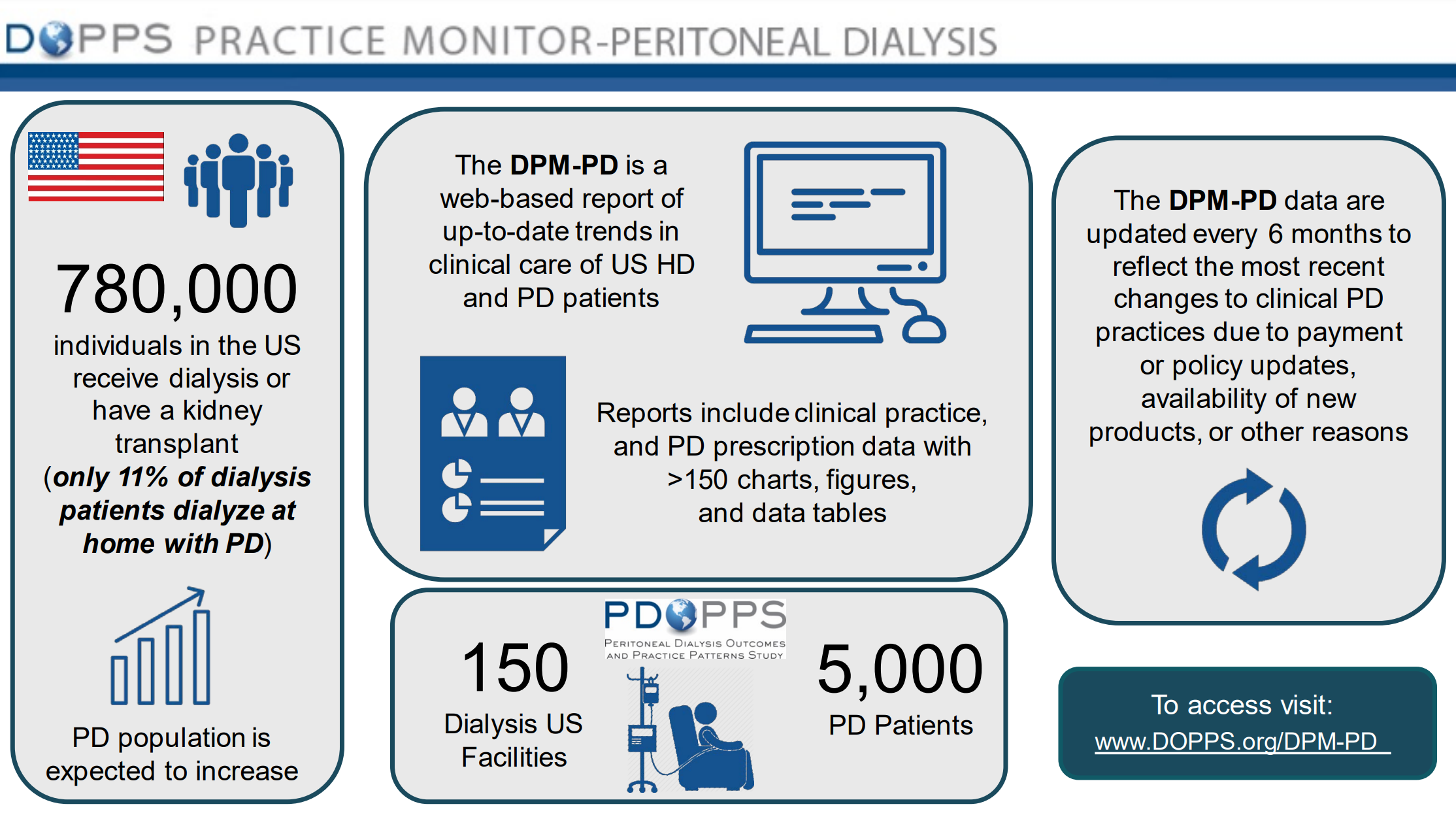Share
Share

The Dialysis Outcomes and Practice Patterns (DOPPS) Program at Arbor Research Collaborative for Health is pleased to announce the expansion of our DOPPS Practice Monitor (DPM) to include peritoneal dialysis (PD). The DPM-PD now reports the most up-to-date trends in care for patients receiving chronic PD in the US.
The DPM-PD is at: https://www.dopps.org/DPM-PD
Over 780,000 individuals in the US receive dialysis or have a kidney transplant because of kidney failure, with this number expected to grow to over 1 million by 2030. Among treatment options for kidney failure, the imperative has never been greater to increase the use of PD, a home-based dialysis modality. PD is widely recognized to be more patient-centric than in-center HD, but is markedly under-utilized (11% of dialysis patients, versus 88% for in-center HD). The US kidney community is watching at this moment as major federal policy changes are implemented this year that may finally spur greater PD use.
What does the DPM-PD show? Why?
Since 2010, the DPM for in-center HD patients (DPM-HD) has reported the most up-to-date trends in clinical care of US hemodialysis patients – including changes due to payment or policy updates, availability of new products, or for other reasons. The DPM-PD is now poised to do the same for the US PD community, presenting a wide range of patient characteristic, clinical practice, and PD prescription data in the form of more than 150 charts, figures, and data tables.
Where does the DPM-PD get its data?
The DPM-PD facility sample includes approximately 150 dialysis facilities, selected by stratified random sampling from two large US dialysis organizations, and from small and medium-chain facilities utilizing Clarity dialysis electronic health record software (Visonex®, Green Bay, WI).
How large is the sample?
The DPM-PD includes anonymized data from nearly 5,000 PD patients, ~8% of the US PD population. Sampling weights are applied to report data that are representative at the national level.
How current are the data?
Data are updated every six months, with only a two-month lag between data collection and web posting.
Who has access to the DPM-PD?
The DPM-PD is intended as a resource to the US kidney community and is publicly accessible to all.
About the DOPPS Program
Our goals are to improve the experience of patients with kidney disease by understanding current clinical practice, identifying practices associated with best outcomes, and serving as a resource for the kidney community. Started as a hemodialysis study in 1996, the DOPPS Program now follows over 70,000 patients at more than 750 clinical sites in approximately 20 countries. We focus on the lives of individuals with advanced non-dialysis chronic kidney disease (CKDopps) or with kidney failure treated by in-center hemodialysis (DOPPS) or peritoneal dialysis (PDOPPS). DPM-PD data are from the US arm of PDOPPS.
The DOPPS Program is funded by a consortium of private industry, professional societies, and public funding sources. Please visit DOPPS.org to learn more about the DOPPS Program, our support, and opportunities for collaboration, and sign up here to receive updates.
Arbor Research Collaborative for Health (Arbor Research), a leading provider of innovative solutions in healthcare research, is pleased to announce its participation in the upcoming World Congress of Nephrology (WCN) 2024, scheduled to take place from April 13th to 16th, 2024. The WCN 2024 conference, organized by the International Society of Nephrology (ISN), is a […]
Arbor Research is pleased to announce the appointment of Dr. Steve Hines, PhD as a Senior Research Scientist focusing on health services research and strategic partnerships. Dr. Hines brings a wealth of experience and expertise, having most recently led learning community activities for the AHRQ-funded TAKEheart project while his work updating AHRQ’s TeamSTEPPS training curriculum […]
Advancing the scientific understanding of kidney disease to inform healthcare practice and policy is at the core of Arbor Research’s history. Founded in 1996 in Ann Arbor, Michigan by three leaders in chronic kidney disease care and research, we were originally named the University Renal Research and Education Association (URREA). Arbor Research’s first project was […]
The Dialysis Outcomes and Practice Patterns Study (DOPPS) Program at Arbor Research Collaborative for Health is pleased to share their recent publication recognized as one of the most- downloaded articles at Kidney International Reports in the past few weeks titled “Alkaline Phosphatase and Parathyroid Hormone Levels: International Variation and Associations With Clinical Outcomes in the […]